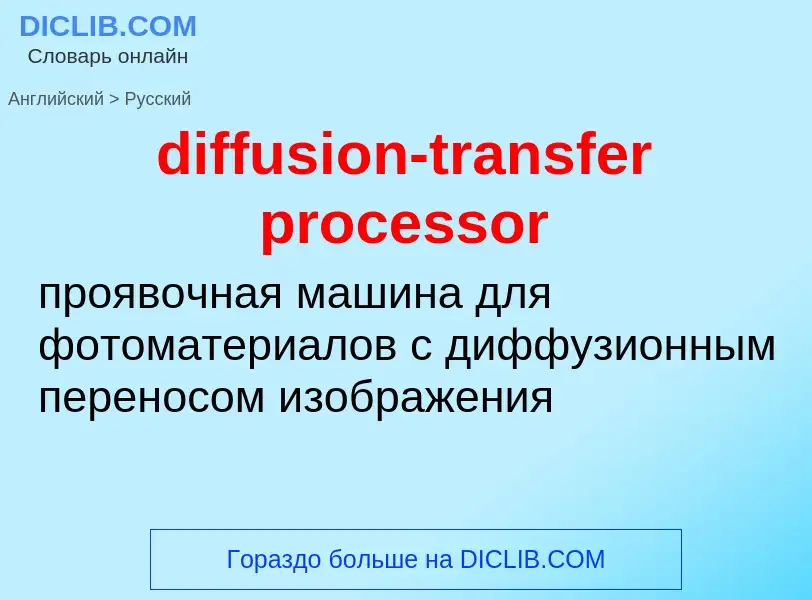Перевод и анализ слов искусственным интеллектом ChatGPT
На этой странице Вы можете получить подробный анализ слова или словосочетания, произведенный с помощью лучшей на сегодняшний день технологии искусственного интеллекта:
- как употребляется слово
- частота употребления
- используется оно чаще в устной или письменной речи
- варианты перевода слова
- примеры употребления (несколько фраз с переводом)
- этимология
diffusion-transfer processor - перевод на русский
общая лексика
диффузионная сварка
общая лексика
блок обработки данных
нефтегазовая промышленность
нефтехимическая установка, технологическая установка для нефтепереработки
обрабатывающее устройство
[tek'nɔlədʒitrænsfə:]
общая лексика
передача технологии (из военных в мирные отрасли, из развитых в развивающиеся страны и т. п.)
нефтегазовая промышленность
передача технологии (процесс распространения научно-технических знаний; практическое использование научных знаний, полученных в другой организации; переход от фундаментальных знаний к техническим средствам; приспособление существующей техники к новому использованию)
2) растрачивать, расходовать
Определение
Википедия
The diffusion of plasma across a magnetic field was conjectured to follow the Bohm diffusion scaling as indicated from the early plasma experiments of very lossy machines. This predicted that the rate of diffusion was linear with temperature and inversely linear with the strength of the confining magnetic field.
The rate predicted by Bohm diffusion is much higher than the rate predicted by classical diffusion, which develops from a random walk within the plasma. The classical model scaled inversely with the square of the magnetic field. If the classical model is correct, small increases in the field lead to much longer confinement times. If the Bohm model is correct, magnetically confined fusion would not be practical.
Early fusion energy machines appeared to behave according to Bohm's model, and by the 1960s there was a significant stagnation within the field. The introduction of the tokamak in 1968 was the first evidence that the Bohm model did not hold for all machines. Bohm predicts rates that are too fast for these machines, and classical too slow; studying these machines has led to the neoclassical diffusion concept.


![Animation of sheet forming process using diffusion welding (see also [[hydroforming]]). Animation of sheet forming process using diffusion welding (see also [[hydroforming]]).](https://commons.wikimedia.org/wiki/Special:FilePath/Output 9GbY2F.gif?width=200)


![In 1996, Dutchman [[Edgar Davids]] was the first high-profile player to move on a free transfer via the [[Bosman ruling]]. In 1996, Dutchman [[Edgar Davids]] was the first high-profile player to move on a free transfer via the [[Bosman ruling]].](https://commons.wikimedia.org/wiki/Special:FilePath/Edgar Davids.jpg?width=200)
![[[John Hartson]] failed medical tests which led to the shelving of three potential transfers in 2000. [[John Hartson]] failed medical tests which led to the shelving of three potential transfers in 2000.](https://commons.wikimedia.org/wiki/Special:FilePath/Hartson, John.jpg?width=200)
![Bayern Munich]] from [[RB Leipzig]] for a world record-breaking fee of €25 Million in 2021. Bayern Munich]] from [[RB Leipzig]] for a world record-breaking fee of €25 Million in 2021.](https://commons.wikimedia.org/wiki/Special:FilePath/Julian Nagelsmann 2020.jpg?width=200)
![[[Neymar]] (right) and [[Kylian Mbappé]] (left) are the two most expensive association football transfers. [[Neymar]] (right) and [[Kylian Mbappé]] (left) are the two most expensive association football transfers.](https://commons.wikimedia.org/wiki/Special:FilePath/Mbappe Messi Neymar.jpg?width=200)
![Barcelona]] in 2013 became the subject of investigation. Barcelona]] in 2013 became the subject of investigation.](https://commons.wikimedia.org/wiki/Special:FilePath/Neymar Barcelona presentation 1.jpg?width=200)

![[[Zinedine Zidane]] was the most expensive player in the world for eight years. [[Zinedine Zidane]] was the most expensive player in the world for eight years.](https://commons.wikimedia.org/wiki/Special:FilePath/Zidane Zizu.jpg?width=200)
![Diffusion furnaces used for [[thermal oxidation]] Diffusion furnaces used for [[thermal oxidation]]](https://commons.wikimedia.org/wiki/Special:FilePath/Centrotherm diffusion furnaces at LAAS 0481.jpg?width=200)

![Diffusion from a microscopic and b macroscopic point of view. Initially, there are [[solute]] molecules on the left side of a barrier (purple line) and none on the right. The barrier is removed, and the solute diffuses to fill the whole container. <u>Top:</u> A single molecule moves around randomly. <u>Middle:</u> With more molecules, there is a statistical trend that the solute fills the container more and more uniformly. <u>Bottom:</u> With an enormous number of solute molecules, all randomness is gone: The solute appears to move smoothly and deterministically from high-concentration areas to low-concentration areas. There is no microscopic [[force]] pushing molecules rightward, but there ''appears'' to be one in the bottom panel. This apparent force is called an ''[[entropic force]]''. Diffusion from a microscopic and b macroscopic point of view. Initially, there are [[solute]] molecules on the left side of a barrier (purple line) and none on the right. The barrier is removed, and the solute diffuses to fill the whole container. <u>Top:</u> A single molecule moves around randomly. <u>Middle:</u> With more molecules, there is a statistical trend that the solute fills the container more and more uniformly. <u>Bottom:</u> With an enormous number of solute molecules, all randomness is gone: The solute appears to move smoothly and deterministically from high-concentration areas to low-concentration areas. There is no microscopic [[force]] pushing molecules rightward, but there ''appears'' to be one in the bottom panel. This apparent force is called an ''[[entropic force]]''.](https://commons.wikimedia.org/wiki/Special:FilePath/DiffusionMicroMacro.gif?width=200)

